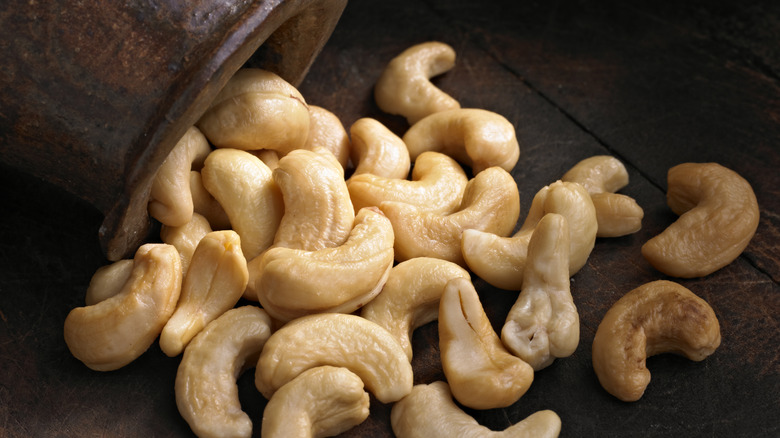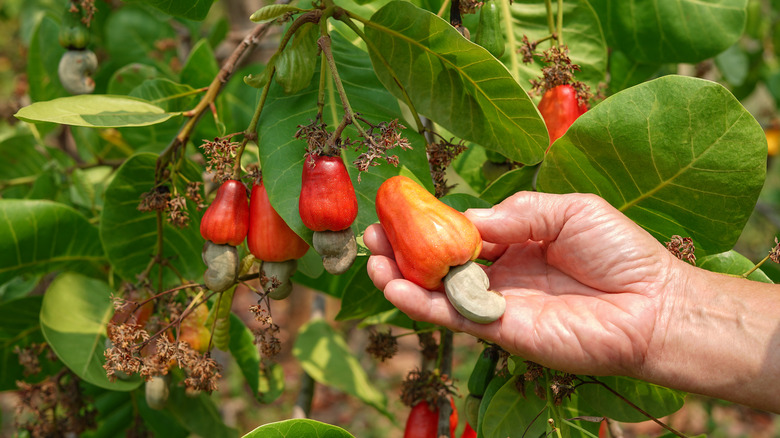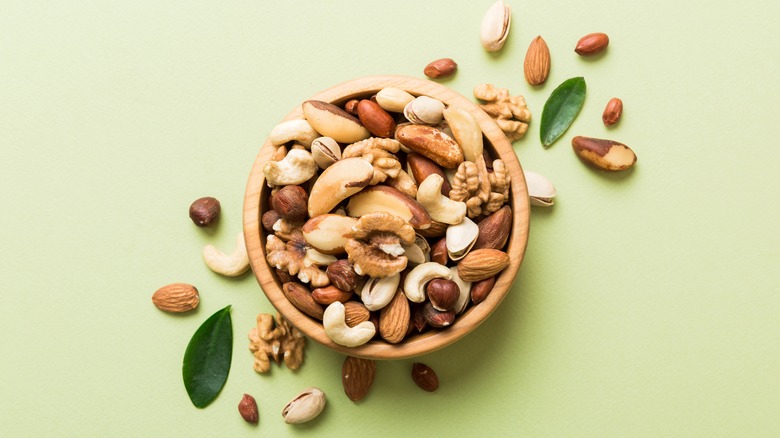Cashews Actually Aren't A Nut At All
Nuts have long been internationally touted as a delicious snack, and for consumers today, there's no shortage of types to choose from. They're not only a great source of nutrients, delivering protein and essential minerals like calcium, iron, magnesium, zinc, and selenium, but – per a 2021 study for The International Journal of Environmental Research and Public Health – they can also increase metabolic health when routinely consumed as part of a balanced diet. But despite how commonly we eat them, we may not actually understand nuts all that well.
Among the world's five most consumed nuts of 2023 (via InsiderMonkey), only one is actually a nut. While a peanut being botanically classified as a legume may not be too much of a stretch for the imagination (they grow in the ground, after all), realizing that cashews fall into a category you've probably never heard of — the drupe — might. Unlike a nut, which is botanically defined as dried fruit with a single seed enclosed within a hard shell, like pecans and chestnuts, the drupe is a fleshy fruit that develops around a plant's seed, which is enclosed with a thin exterior shell. Coffee beans, peaches, and olives are also classified as drupes.
Cashews grow very differently from nuts
You may have experience removing a pecan, walnut, or peanut shell, but even if not, you can probably envision them. Regardless of botanical classification, walnuts, almonds, hazelnuts, brazil nuts, and many other ingredients referred to as nuts grow inside hard, neutrally colored shells or husks.
But if you've never seen how cashew grows, you may be surprised by what you find. They're produced by the Anacardium occidentale, a member of the sumac family that is native to Brazil but is cultivated in tropical climates around the world. Rather than being enclosed in a thick, hard shell, the cashew has a thin exterior shell that seems to descend from what is called the cashew apple — a bright red, fleshy stem that looks something like a bell pepper or pear. While you may guess the cashew grows out from the cashew apple, in actuality, the seed develops first. Once fully grown, its stem becomes fuller, expanding until it is enveloped within the cashew apple.
The reason you never see cashews sold in their whole form, apple included? While both components are edible, the portion we commonly eat grows within a thin shell that contains urushiol— the same irritant found in poison ivy and poison oak. They must be carefully harvested and roasted or steamed in high heat before handling or eating (per Healthline). And the apple itself is often too perishable for shipping.
Why cashews and other foods are so confusing
The reason we think of cashews as nuts rather than drupes is that we prioritize nutritional and culinary classifications over botanical ones in our day-to-day lives. While botanists carefully study and organize plant life into different categories based on similarities in how they grow and develop, it's more common for cooks to group things based on how they're used and what they taste like.
We classify savory plants as vegetables and sweet plants as fruits, even though those categories aren't always accurate botanically — tomatoes are technically fruits, and watermelon is sometimes considered a vegetable. While popular groupings aren't always accurate, they allow us to subconsciously communicate the flavor, texture, nutritional value, and other culinary characteristics of an ingredient — even to someone who has never eaten it before. So even if your favorite trail mix to pack for travel days also contains drupes, legumes, and seeds, they're all delivering the satisfying crunch and hit of nutrients we expect from nuts —even if the title is technically a myth in the case of cashews.



